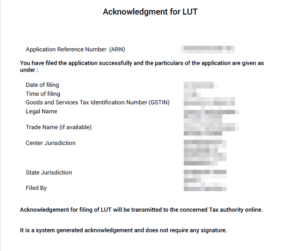LUT in GST
Need help filing your LUT in GST? Avoid paying IGST on exports by submitting your Letter of Undertaking on time. Our experts ensure quick, error-free LUT filing, so your business stays compliant and tax-efficient. Don’t wait—file your LUT in GST today and simplify your export process. Contact us now!
- All India Service
- Easy Onlie Process
- 24*7 Hours Customer Support
LUT in GST for FY 2025-26
A Letter of Undertaking (LUT) is an important document for exporters in the Goods and Services Tax (GST) framework. It enables them to export goods and services without having to pay the Integrated Goods and Services Tax (IGST) upfront, resulting in significant cash flow benefits and increased global market competitiveness.
What is LUT in GST?
The LUT stands for Letter of Undertaking, which is a document that exporters use under GST to make zero-rated exports without having to pay IGST (Integrated Goods and Services Tax) at the time of export. It allows exporters to ship goods or services overseas without the burden of upfront taxes, ensuring a smoother export process. Instead, the tax is typically claimed as a refund later, provided certain conditions are met.
The concept of the LUT in GST was introduced to simplify the export procedure, removing the need for exporters to pay taxes upfront and subsequently apply for refunds. It is an important tool for businesses involved in international trade.
Eligibility for LUT Filing
Under GST, not all exporters are required to submit an LUT. According to Section 16 of the IGST Act, businesses that have been registered under GST and are involved in the export of goods or services can apply for an LUT for GST. However, to qualify for the LUT, businesses must meet the following criteria:
- They should not have been prosecuted for any offense under GST or any other similar laws.
- The exporter must be able to prove that the export proceeds are received within the specified time frame.
Documents Required for LUT in GST
- GST User id and Password
- Pan card of 2 Witness
- Adhaar card of 2 Witness
- Occuptation of Both Witness
- Cancel Cheque of Entity
- Copy of Last Filed LUT (if any)

Validity of LUT (Letter of Undertaking)
The validity of the LUT in GST is typically for one financial year. For the FY 2025-26, exporters will need to file their LUT before the start of the fiscal year, or they can file it any time during the year. The submission of LUT is mandatory for those opting to export goods or services under the zero-rated tax mechanism.
Benefits of LUT in GST?
1. Zero Rate of Tax
The main benefit of filing an LUT in GST is that it allows exporters to conduct business without the burden of paying taxes on exports. This effectively makes the export of goods and services zero-rated.
2. Faster Refund Process
Since exporters don’t pay IGST, they don’t need to claim refunds, which can often be a lengthy and cumbersome process. The LUT ensures that the export transaction proceeds without tax delays.
3. Improved Cash Flow
By eliminating the need to pay taxes upfront, businesses can have more liquidity and improve their cash flow, especially for small and medium-sized enterprises (SMEs) involved in international trade.
4. Simplification of Export Procedures
The LUT in GST mechanism simplifies the overall export procedure by reducing paperwork and eliminating the need for tax payments on exports.
Important Point To Remember for filing of LUT
- An LUT remains valid for current financial year from the date of its submission. Example- If LUT was furnished in FY 2025-2026, then the date of expiry of the validity of such LUT is 31st March 2026. Therefore, you need to file fresh LUT for FY 2026-2027.
- NO bank guarantee required in case of letter of undertaking in GST.
- The LUT must be duly applied and signed by the authorised signatory of the company, firm, etc.
File Your LUT in GST Easily Today
Avoid IGST on exports. File your LUT in GST quickly with expert help. Stay compliant and save taxes. Contact us now!
FAQ on LUT in GST
A Letter of Undertaking (LUT) is a formal declaration submitted by exporters to the GST authorities. It allows them to export goods or services without having to pay Integrated Goods and Services Tax (IGST) at the time of supply.
Any registered taxpayer engaged in the export of goods or services can file an LUT, provided they meet certain eligibility criteria. This includes exporters who wish to avoid paying IGST on their exports.
To be eligible for filing an LUT, exporters must:
- Be a registered taxpayer under GST.
- Be engaged in the export of goods or services.
- Have no pending tax liabilities or arrears.
- Maintain a satisfactory compliance track record, including timely filing of GST returns.
- A cover letter requesting the LUT, signed by an authorized person.
- Details of two independent witnesses.
- Any previously approved LUTs (if applicable).
An LUT is valid for one financial year. Exporters must renew their LUT annually if they wish to continue exporting without paying IGST.
If you do not file an LUT before exporting, you may be liable to pay the full amount of IGST along with potential penalties, which can be up to 100% of the IGST that should have been paid.
Yes, it is advisable to mention the LUT number on invoices related to exports made under the Letter of Undertaking to ensure compliance and facilitate processing.
If your application is rejected, you will receive a notice explaining the reasons for rejection. You may then address these issues and reapply.











